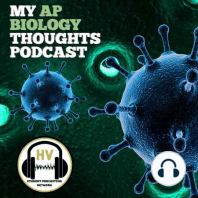7 min listen
Intro to Signaling Transduction Pathway
ratings:
Length:
8 minutes
Released:
May 25, 2021
Format:
Podcast episode
Description
My AP Biology ThoughtsUnit 4 Cell Communication and Cell CycleWelcome to My AP Biology Thoughts podcast, my name is Nikki Evich and I am your host for episode#82 called Unit 4 Cell Communication and Cell Cycle: Intro to Signaling Transduction Pathway. Todaywe will be discussing the components that make up a pathway.Segment 1: Introduction to the signaling transduction pathway● Signal also call ligand binds to a receptor on target cell membrane○ , starts the pathway,○ had to fit receptor,○ once bound, transduction is initiated● Receptor- intracellular or extracellular○ Binding domain recognizes specific chemical messengers● transduction-lots of varian with transduction○ Could activate inactive protein by phosphorylating○ Amplifies with secondary messengers● Response- what the end result is○ Can be short or long○ Activate enzyme or move cell-short○ Alter gene expression levels or cell division (apoptosis)-longSegment 2: More About the signaling transduction pathway● Type 1● Once the food is broken down into glucose, these molecules are then absorbed into the bloodstream.The high glucose levels in the bloodstream activate the beta cells in the pancreas to start producinginsulin. Insulin is a hormone created in the pancreas. In the pancreas, beta cells are present which arein charge of secreting the insulin into the bloodstream once they detect an increase in blood glucose.Insulin travels to three main destinations-muscle, fat, and liver cells.● This is where the transduction pathway happens● The insulin will then bind to the insulin receptors. The insulin receptors are made up of extracellularalpha subunits and transmembrane beta subunits.● When the insulin binds to the extracellular alpha subunits, the beta subunits become activated and autophosphorylate. This means that they phosphorylate themselves.● This leads to the phosphorylation and activation of the IRS protein. The IRS protein is regulated andcan be phosphorylated by PTEN. PTEN can regulate phosphorylation and activate IRS Isaforms...
Released:
May 25, 2021
Format:
Podcast episode
Titles in the series (100)
Natural Selection Mechanism by My AP Biology Thoughts
